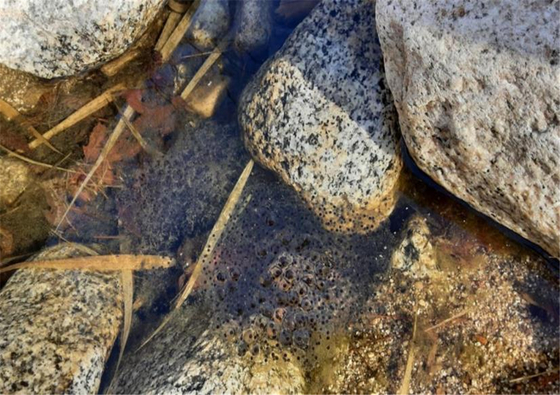
First spawning of northern mountain frogs in 2021 in Guryong Valley in Jirisan National Park. Hundreds of black eggs are gathered, and a transparent jelly-like substance surrounds the whole to form an egg mass. Photo National Park Authority
The first frog egg from Jirisan in spring appeared on the 27th faster than 11 years ago.
The National Park Service announced on January 10 that it observed the first spawning of northern mountain frogs in the Guryong Valley in Jirisan National Park this year. At the time of the first observation in 2010, 11 years ago, it was 27 days earlier than February 22.
‘Spring messenger’ frog egg, second observation in January after last year

The appearance of a northern mountain frog. It is a common species that can be found anywhere in Korea. Photo National Park Authority
The Northern Mountain Frog is a species distributed throughout Korea, and is also a climate change species designated by the Ministry of Environment as an indicator of climate change observation. It is a species that can be easily seen, and because females lay only one egg during the spawning season from February to April, it is easy to identify the number of individuals and is therefore widely used for ecological monitoring.

Northern mountain frog spawning observation date and expected observation date in 2021. Materials National Park Service
Since 2010, the National Park Service has recorded the first spawning period of northern mountain frogs in the Guryong Valley area of Mt. This is the second time that spawning was confirmed in January since last year’s January, when the highest winter temperature was ever recorded.
The first spawning from 2010 to the present was March 4, 2015, and the fastest on January 23 of last year. In addition to Jirisan, Jeju Island, Wolchulsan, Mudeungsan, Woraksan, Sobaeksan, Odaesan, Seoraksan, and Gwanggyosan are also investigating the spawning period of northern mountain frogs, but these spots have a short observation period of around 5 years.
When December is warm, eggs are laid quickly
The researchers believe that as the winter weather warms each year, the first spawning of northern mountain frogs also accelerates. Dr. Park Hong-cheol, who is in charge of monitoring ecosystems according to climate change at the National Park Research Institute, said, “The spawning period of northern mountain frogs is analyzed to be particularly affected by the average temperature in December.” “The average temperature in December near the Guryong Valley in Jirisan for 11 years It has risen by 1.2 degrees, and as the temperature rise trend continues, the scattering in January will not be difficult to observe.”
This year, in Jeju Island, the northern mountain frog laid its first egg on January 20, and spawning was observed on January 25 in Wolchulsan. The National Park Service predicts that the first spawning of northern mountain frogs will be confirmed in mid-February in Woraksan, mid-late February in Sobaeksan, and early March in Seoraksan and Odaesan.
Reporter Kim Jeongyeon [email protected]
